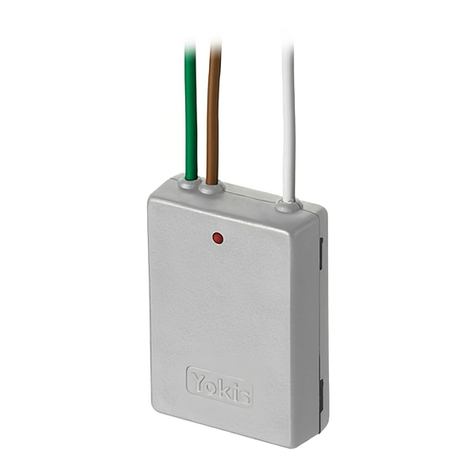
GB
5454402 2-channel flush-mounted transmitter
All YOKIS transmitters are compatible with
YOKIS receivers
(Relays, Dimmer and Shutter Modules).
RADIO RANGE:
Standard range:
•In the same room (< 100 m²)
•50m in open range
(Range may be reduced by presence of metallic
elements, crossing of walls or partitions)
Power range (*):
•Inside 100m² apartments with perpendicular
crossing of main wall or ceiling
•250m in open range
(Range may be reduced by presence of metallic
elements, crossing of walls or partitions)
RADIO TRANSMISSION:
The transmitter LED lights up only if radio
transmission was successful.
Adding an intermediate receiver will allow to solve a
problem of insufficient range (see § “How to increase
the range”).
The E2BP/E2BPP may be wired behind pushbuttons (or switches) of any model. Wiring
both channels is not indispensable: a single pushbutton can be used connected to a single
channel.
Switches can be used instead of pushbuttons to drive MTR2000ER receivers. In this
case, switch 5 times rapidly (not 10!) instead of using the 5 press sequence. Repeat the
connection procedure by pressing 5 times to use a pushbutton again instead of the switch.
D I R E C T M O D E
Press the pushbutton to be connected on the
transmitter (E) 5 times**.
The transmitter LED will start flashing for 30
seconds, indicating that the system is waiting
for connection.
** Each press must last less than 0.7 seconds
Briefly press the pushbutton in the ‘connect’hole
of the receiver (R) (on the front or the back of the
receiver) with the point of a pencil while the
transmitter LED is flashing.
The transmitter LED will stop flashing.
Warning: the receiver must be powered.
DIRECT MODE CENTRALISATION
A command can be centralised by repeating the same procedure on up to four receivers. In case that more
than 4 receivers should be driven, use the Radio Bus.
(*) Contact an Urmet retailer or go to www.yokis.com/ for information on availability.
P8
E2BPX
TLC2C
TLC8C
GALET8T
TLM1T45
TLM2T45
5454401
5454403 8-pushbutton remote control
5454405 8 pushbutton flat remote control
5454411 1-pushbutton wall-mounted remote
5454406 2-pushbutton wall-mounted remote
5454412 4-pushbutton wall-mounted remote control
POWER with external aerial
NEW POWER RANGE (soon available *)
E2BPP
5454413 2-channel flush-mounted POWER transmitter
TLC2CP
5454415 2-pushbutton POWER remote control
TLC8CP
5454423 8-pushbutton POWER remote control
GALET8TP
5454424 8 pushbutton flat POWER remote control
TLM1T45P
5454417
TLM2T45P
5454419
TLM4T45P
5454421
control
- CR2032 Lithium battery (included)
- Battery life > 7 years
- Max. 4 receivers per transmitter button
- Operating temperature: from -10 to +
- IP54 protection
- Max. relative humidity 80%
- Frequency: 2,4 GHz
- Transmission: two-way
1
2
The LED will light up on transmitters
RADIO TRANSMITTERS
























